Creating a Workflow
Automated Workflow Requirements
- Run Search Term Report step is only available on Relativity Server 2022 and Server 2023
- Populate, Build, and Activate Analytics Index step is only available if an Analytics Server is properly set up, licensed, and configured. In addition, Analytics Relativity Application must be installed in the workspace where the automated workflow is being created.
- Run Structured Analytics Set step is only available if an Analytics Server is properly set up, licensed, and configured. In addition, the Structured Analytics Relativity Application must be installed in the workspace where the automated workflow is being created.
Creating a Workflow
To get started, navigate to the Automated Workflows tab in a workspace where Delegate has been installed.

Click New Workflow.
- Name: Name used to Identify the workflow.
- Description: Explanation of the Workflow.
- Emails to Notify on Workflow Complete: Email addresses that will be notified when this workflow completes.
- Default Emails to Notify on Step Failure: Email addresses that will be notified if a step fails or a step partially completes.
- Default Emails to Notify on Step Complete: Email Addresses that will be notified when a step completes.
Trigger: New Documents Loaded
This trigger allows workflows to execute automatically when new Documents are loaded into a workspace.

What to Know
- Activation: Initiates when a new document record is created in the database.
- Exclusions: Does not trigger for document updates, including changes in metadata or overlaying images, natives, productions, metadata.
During execution, configured workflows with this trigger will check every 5 minutes (by default) to determine if execution is necessary. While a workflow is in progress, the periodic check is temporarily suspended to prevent interruptions.
If the workflow has been executed before, any documents loaded after the last execution are considered new. For workflows that have never been executed, documents loaded after the document load trigger is first configured are treated as new.
An Instance Setting can be configured to set the interval for how long to wait between the last document being loaded and the workflow execution starting.
| Name | MinutesElapsedSinceLastDocumentLoaded |
|---|---|
| Section | Milyli.Delegate |
| Description | The amount of time, in minutes, a workflow will trigger after a document has been loaded into a workspace with no additional documents loaded within that window. |
| Initial Value | 5 |
Trigger: Manual, Scheduled, or Recurring
This trigger allows a user to define when an automation is ran. The trigger type can be set to Manual, Weekly Recurring, Daily Recurring , or Scheduled.
What to Know
- When executing a Recurring or Scheduled Trigger the user must select a date and time of day that are in the future. This time will be choosen in a UTC format and a message will be shown to the user indicating the selected date and time of day represented in the local time zone when the workflow will run.
- The user must also choose if the the workflow will automatically trigger on the configured settings by checking the Active option. If this is left unchecked the workflow will be disabled from automatically executing.
Manual
Manual is the default setting for workflows. When this option is chosen the execution can only be initiated by clicking the run button.
Scheduled
Users can schedule a workflow to run once at a specific date and time in the future using the Scheduled trigger type.
Recurring
Users can schedule a workflow to run daily, weekly, or monthly by selecting the Recurring trigger type.
Click on the Images to Zoom in.
Step Notification and Error Behavior
Every step has individual step configuration for how the workflow behaves. Options are available for determining behavior in the event of steps resource erroring, completing partially, or succeeding. This includes individual options for notifications.

Users can choose to pause the workflow in two scenarios. If the Relativity resource fails for any reason and ends in an error, the workflow can be paused. By default, this option is checked. Paused workflows provide several actions that your team can take detailed later in this documentation.
A second pause option is available for partial complete. Partial complete is unique to every Relativity resource. For example, Image Sets are considered partially complete if a handful of documents fail to image. Relativity does not error out the image set in this scenario but continues through the remaining documents. By default, this is unchecked as there is additional nuance to be considered based on your team's requirements.
Finally, the third layer of notification configuration is displayed here. The email notifications at the step level reflect the workflow settings by default. These can be removed or modified on a step-by-step basis. The notification options for error and partial complete are checked by default.
Workflow Complete Step
The Workflow Complete Step is triggered at the end of every workflow after all steps have completed without pausing the workflow. The complete step does not require all steps to be successful, just that all steps have run.
The workflow complete step is represented by a green step that cannot be moved or removed.

The workflow complete notification is optional. Simply clear the “Emails to Notify on Workflow Complete” field and the workflow complete notification will be skipped.


Delay Step
The Delay Step is used to delay a set amount of seconds before moving on to the next step. When the stopwatch hits the time specified in the step, it will move to the next step. The only input is an integer that represents seconds.
Run Relativity Integration Point Step
The Run Relativity Integration Point Step allows users to configure a RIP job to run within a workflow. To enable this, specify the Integration Point you wish to execute. Please note that this step is only available if the Integration Points application is installed.
Pause Workflow Step
The Pause Workflow Step allows users to pause a workflow and notify relevant stakeholders via email. When executed, this step will pause the workflow and trigger the email notification. Users will have to manually resume the workflow to continue progressing through future steps.
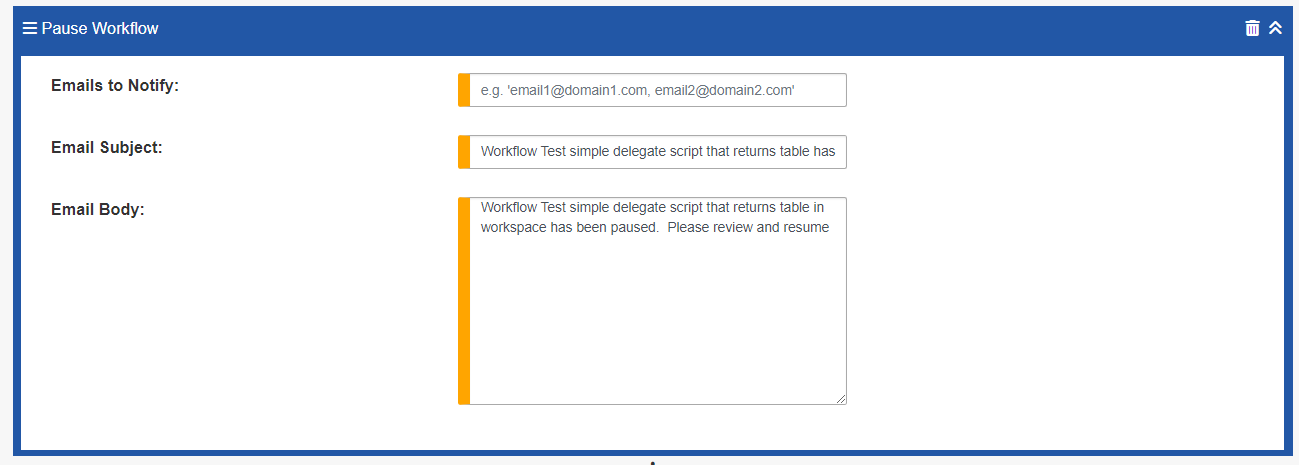
Update Field Step
The Update Field Step will calculate the size of a long text field and populate the value to a document field. To use this step define the target documents using a saved search, select the field to be updated, and specify the new value.
Supported field types include:
- Fixed-length text
- Long text
- Date
- Whole number
- Decimal
- Currency
- Yes/no
- User
- Single object

Set Long Text Field Size Step
The Set Long Text Field Size Step will calculate the size of a long text field and populate the value to a document field.

Run Imaging Set Step
The Run Imaging Set Step will list a dropdown to select an Image Set within the Workspace. Upon step execution, the Imaging Set will be run in Relativity. If the imaging queue is full, the Imaging Set will be automatically queued by Relativity and Delegate will continue to wait for the step to run.
The configuration and setup of your relativity instance dictates how this resource will be executed and Delegate provides no way to override the built-in Relativity queuing and load balancing.
The Run Imaging Set Step gives teams flexibility to include imaging sets and ensure their execution before review starts. This step pairs well with other steps that depend on images existing such as the Run OCR Set Step. The Run Imaging Set Step behaves exactly as if the imaging set was run manually via the Imaging Sets tab in Relativity.
Run OCR Set Step
The Run OCR Set Step provides options for selecting an OCR Set within the workspace. Upon step execution, the OCR Set will be run in Relativity. If the OCR queue is full, the OCR Set will be automatically queued by Relativity and Delegate will continue to wait for the step to run.
The configuration and setup of your relativity instance dictates how this resource will be executed and Delegate provides no way to override the built-in Relativity queuing and load balancing.
The Run OCR Set Step gives teams the ability to include OCR Set execution as a part of their workflows. Delegate can run OCR Sets configured for both Data Sources and Productions. The Run OCR Set Step behaves exactly as if the OCR Set was run manually via the OCR Sets tab in Relativity.
Run dtSearch Set Step
The Build dtSearch Index Step provides options for both running full builds and incremental builds of dtSearch indexes. The step includes an option for always forcing a full build. If this option is not selected, an incremental build will be executed.
It is important to note that the dtSearch index building behavior in Relativity is already very defensive. If the step is configured to run incrementally, it will still run a full build if the dtSearch Search Index has never been built before. These built-in protections help prevent the step configuration from creating a broken dtSearch execution.
Run Structured Analytics Step
The Run Structured Analytics Set Step enables the execution of structured analytics sets as a part of your workflows. With this step, Email Threading, Name Normalization, Textual Near Duplicate Identification, Language Identification, and Repeated Content Identification can be included in your automated workflows. We strongly recommend following the Relativity guidelines for setting up structured analytics sets when planning to include them in your automated workflows.

When running Structured Analytics Sets from Relativity, several options are presented.
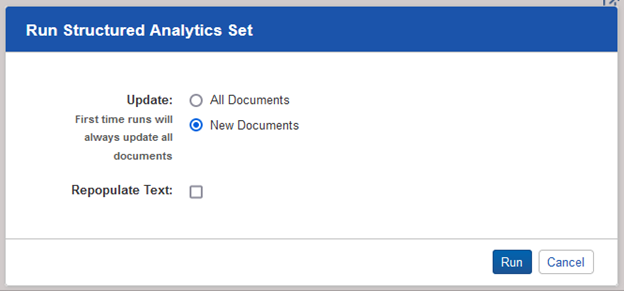
These options have been recreated as a part of step configuration and will be passed to the structured analytics set when executing it. Additionally, the same restrictions are included in the step configuration such as not being able to combine updating new documents when repopulating text. This is displayed clearly in Delegate.
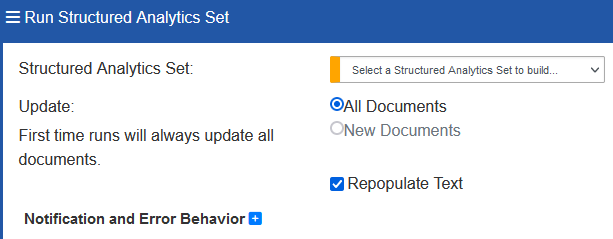
Note: If analytics is not properly configured, this step will not be available for selection.
Populate, Build, and Activate Analytics Index Step
The Populate, Build, and Activate Analytics Index Step allows for the execution of content analytics sets during workflow execution. This includes both conceptual and contextual analytics indexes. When including these steps, the step will perform all 3 major phases of building an Analytics Index including populating the index, building it, and activating it.
Currently, the functionality provided by this step is analog to pressing the “Populate Index: Full” button on the Analytics index view page.
Run Search Term Report Step
The Run Search Term Report (STR) provides the ability to include STRs as a part of your workflows. When running STRs as a part of workflows, they will always run all terms and replace existing data.
Run Relativity Script
With the Run Relativity Script step, running scripts become an integral part of most workflows. The dropdown here has an extra layer of security that prevents the selection of Relativity scripts that the current user does not have access to execute.
If a user navigates to a workflow that already exists, configured with a script they do not have access to, they may run the workflow or change the script to a different script they do have access to, but they will not be able to change it back to the original one.
Export Format
The Export Format option allows the user to choose the exported script results file type. Emails can be provided for where the export will be sent. The exported file can also be accessed from the Run History after the workflow has been completed.
| Server 2022 and Server 2023 | 10.3 and Server 2021 |
|---|---|
| CSV, HTML, PDF, XLS, XLSX, RFT, PNG | CSV |
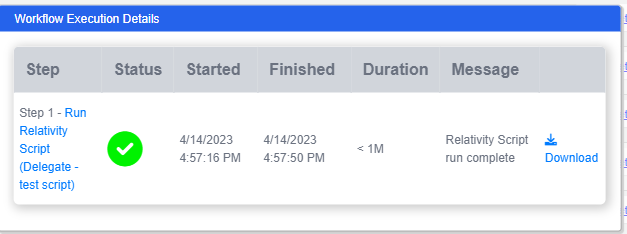
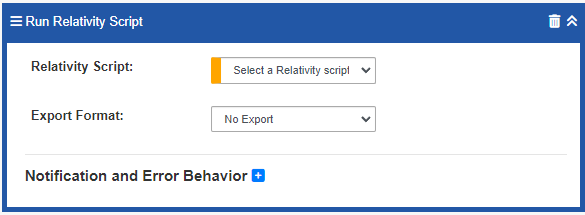
Upon script selection, the step is updated to provide all the field options configured in the script.
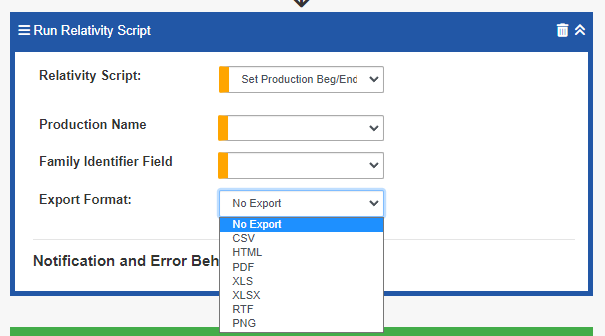
Field Validation
In addition to respecting field requirements on script execution, all script fields are validated upon workflow Create, Save, and Run.
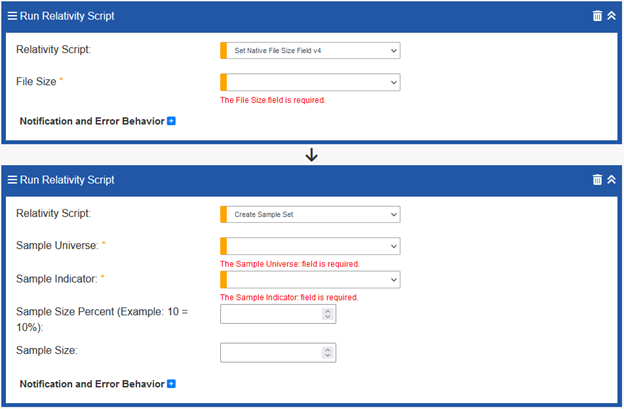
Webhook Step
This step allows the user to call out to a custom webhook that can then trigger other work to be done. This can be used to send notifications to external messaging systems such as Slack or Teams as well as start other workflows in other systems or within Delegate.
The Webhook Step issues a post request to a configured URL with some basic information about the workflow in the request body. The provided URL must be HTTPS.
